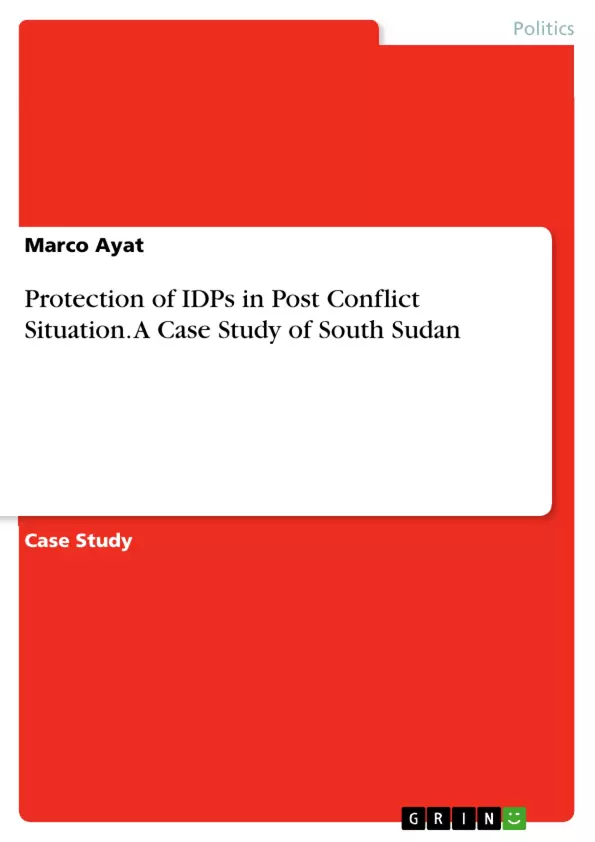The problem of displacement became severe in nature and a world’s concern. Africa is one of the continents most affected by this trend. This research is focusing on the protection of internally displaced people in South Sudan after the crises that erupted in 2013. It tries to identify challenges and gaps and sheets light on possible solutions.
The research is carried through qualitative methods, data collected through semi-structure interview with key informants and observation. The finding of this study provides evident that contributes to the process towards realization of internally displaced persons in post-conflict-affected situation. The finding here indicates that in the context of South Sudan, it is only when other factors are inter-connected with war, can displacement be induced. This dissertation sees the upcoming implementation of revitalized peace agreement as an excellent opportunity for realization of IDPs problems and working towards finding lasting solution in South Sudan. It recommends adoption of IDPs legal and normative framework.
Inhaltsverzeichnis (Table of Contents)
- Abstract
- Chapter one General Introduction
- 1.1 Introduction
- 1.2 Background
- 1.3 Research focus
- 1.4 Aims and objectives
- Chapter 2: Literature review
- 2.1 Introduction
- 2.2 Background about South Sudan
- 2.2.1 Protection of Civilian sites (PoCs)
- 2.3 Causes of displacement
- 2.4 Legal framework for IDPs protection
- 2.4.1 The Kampala Convention
- 2.5 Mechanism for Protection in light of the legal framework
- 2.5.1 Shelter and Housing
- 2.5.2 Health
- 2.5.3 Food
- 2.5.4 Education
- Chapter 3 Research methodology and methods
- 3.1 Introduction
- 3.2 Research design
- 3.3 Research Strategy
- 3.4 Qualitative versus Quantitative
- 3.5 Data collection
- 3.6 Primary and secondary data analysis
- 3.7 SWOT Analysis
- 3.8 Interview
- 3.9 Observation
- 3.10 Ethical consideration
- Chapter 4 Critical analysis and presentation
- 34.1 Introduction
- 4.2 Key Findings
- 4.2.1 Causes of displacement
- 4.2.2 Factors behind choosing current displaced areas
- 4.2.3 Push and pull factors
- 4.2.4 Enhancement of IDPs' protection
- 4.2.5 Statement of Dr. Francis Deng
- Chapter 5:Conclusion
- 5.1 Research objectives and finding
- 5.2 Recommendations
- 5.3 Future work
- Bibliography
Zielsetzung und Themenschwerpunkte (Objectives and Key Themes)
This research examines the protection of internally displaced persons (IDPs) in South Sudan following the conflict that erupted in 2013. Its primary objective is to identify challenges and gaps in the protection of IDPs and propose potential solutions. The research utilizes qualitative methods, employing semi-structured interviews with key informants and observation to collect data. The findings highlight the complexities of displacement in South Sudan and contribute to ongoing efforts towards achieving lasting solutions.- The impact of armed conflict on the displacement of civilians in South Sudan.
- The challenges and gaps in existing protection mechanisms for IDPs.
- The legal framework for IDP protection, specifically the Kampala Convention.
- The role of various stakeholders in IDP protection, including the government, international organizations, and civil society.
- The potential for the revitalized peace agreement to address the issues of IDPs.
Zusammenfassung der Kapitel (Chapter Summaries)
- Chapter one provides a general introduction to the research, outlining the background, research focus, aims, and objectives.
- Chapter two presents a literature review exploring the context of IDP protection in South Sudan, examining the causes of displacement, the legal framework, and various protection mechanisms.
- Chapter three details the research methodology and methods, including the research design, strategy, data collection techniques, and ethical considerations.
- Chapter four presents a critical analysis of the findings, focusing on the causes of displacement, factors influencing the selection of displacement areas, push and pull factors, and potential enhancements to IDP protection.
Schlüsselwörter (Keywords)
This research centers on the critical issue of internally displaced persons (IDPs) in post-conflict South Sudan, exploring the complexities of displacement and protection challenges within a war-torn context. Key focus areas include: protection, displacement, IDPs, armed conflict, legal framework, Kampala Convention, protection mechanisms, humanitarian assistance, and revitalized peace agreement.- Citation du texte
- Marco Ayat (Auteur), 2018, Protection of IDPs in Post Conflict Situation. A Case Study of South Sudan, Munich, GRIN Verlag, https://www.grin.com/document/946837



